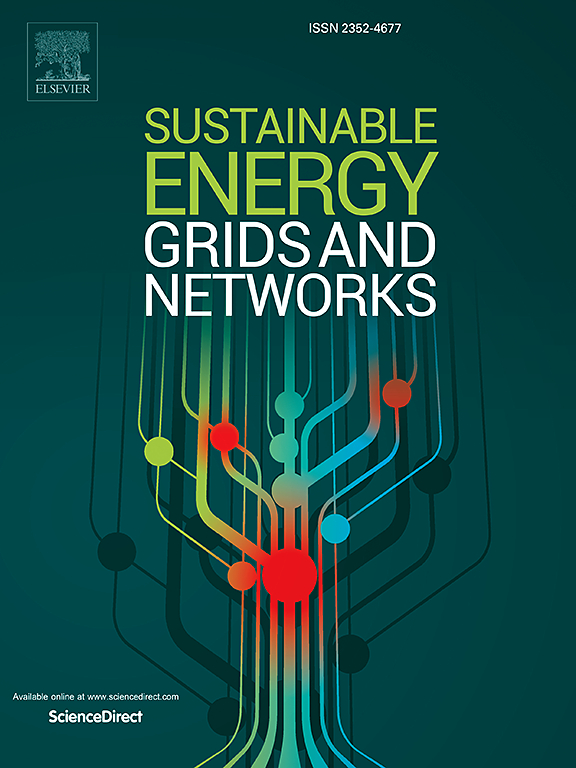A multi-objective strategic planning of smart energy hubs and hydrogen refueling stations toward net-zero emissions
IF 4.8
2区 工程技术
Q2 ENERGY & FUELS
引用次数: 0
Abstract
Hydrogen-based generation and storage technologies have been increasingly emerging as an appealing candidate for decarbonizing different sectors, including microgrids and transportation. Practically, energy hubs (EH) and Hydrogen refueling stations (HRS) could provide an ideal environment for integrating such technologies. However, the management process involves several conflicting objectives that must be met to a satisfactory extent. In this regard, this paper proposes a stochastic bi-level tri-objective optimization framework for the planning and operation of EHs and on-site green/blue HRSs. The multiple objectives involve total cost (i.e., capital, operation and maintenance, Hydrogen, and emissions), load profile deviation resulting from engaging the demand response program (DRP), and the dissatisfaction of fuel cell electric vehicles (FCVs) owners. The proposed model forms a bi-level optimization strategy. The upper-level optimization (i.e., planning level) optimizes the sizes and locations of renewable energy sources (RESs) along with the capacities, rates, and locations of the other resources (i.e., photovoltaic, wind turbine, Hydrogen storage system, thermal storage system) integrated into both EHs and HRSs incorporated into the IEEE-69 system. On the other hand, the lower level (i.e., operation level) precisely optimizes the charging and discharging profiles of the different resources incorporated in EHs and HRSs along with FCVs. The Pareto optimal solution is employed to find the best-compromised solution among the conflicting tri-objective solutions. The simulation results demonstrate that the green-controlled approach has validated its superiority for net-zero emissions transition with a 10.74 % reduction in emissions costs at almost the same total cost compared to the other approaches (i.e., blue-uncontrolled, blue-controlled, green-uncontrolled).
面向净零排放的智能能源中心和加氢站的多目标战略规划
基于氢的发电和储存技术已经越来越多地成为包括微电网和交通运输在内的不同部门脱碳的有吸引力的候选者。实际上,能源中心(EH)和氢燃料补给站(HRS)可以为整合这些技术提供理想的环境。然而,管理过程涉及几个相互冲突的目标,这些目标必须达到令人满意的程度。为此,本文提出了环境健康医院和现场绿蓝健康医院规划与运行的随机双层三目标优化框架。多重目标包括总成本(即资本、运营和维护、氢气和排放)、参与需求响应计划(DRP)导致的负荷分布偏差以及燃料电池电动汽车(fcv)车主的不满。该模型形成了一个双层优化策略。上层优化(即规划层)优化可再生能源(RESs)的规模和位置,以及集成到IEEE-69系统中的EHs和HRSs中的其他资源(即光伏、风力涡轮机、储氢系统、储热系统)的容量、费率和位置。另一方面,下层(即操作层)则对ehhs和hrs中与fcv一起纳入的不同资源的充放电曲线进行精确优化。利用帕累托最优解在相互冲突的三目标解中寻找最优折衷解。仿真结果表明,与其他方法(即蓝色控制、蓝色控制、绿色控制)相比,绿色控制方法在几乎相同的总成本下减少了10.74 %的排放成本,证明了其净零排放转型的优越性。
本文章由计算机程序翻译,如有差异,请以英文原文为准。
求助全文
约1分钟内获得全文
求助全文
来源期刊

Sustainable Energy Grids & Networks
Energy-Energy Engineering and Power Technology
CiteScore
7.90
自引率
13.00%
发文量
206
审稿时长
49 days
期刊介绍:
Sustainable Energy, Grids and Networks (SEGAN)is an international peer-reviewed publication for theoretical and applied research dealing with energy, information grids and power networks, including smart grids from super to micro grid scales. SEGAN welcomes papers describing fundamental advances in mathematical, statistical or computational methods with application to power and energy systems, as well as papers on applications, computation and modeling in the areas of electrical and energy systems with coupled information and communication technologies.
 求助内容:
求助内容: 应助结果提醒方式:
应助结果提醒方式:


